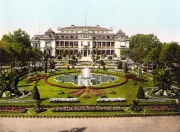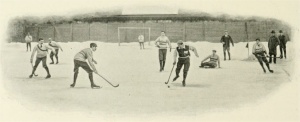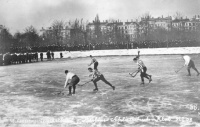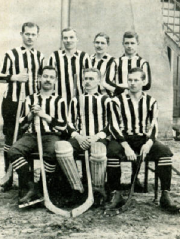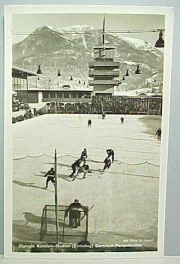History of hockey in Germany (1897-1945)
The history of hockey in Germany from 1897 to 1945 saw the sport evolve and develop in many facets.
Overview
| Ice Hockey in Germany, 1897-1945 |
| Entities: |
| Competitions: Wanderpokal (1901-1904) • Berlin International Tournament (1908-1910) • Berlin Championship (1909-1912) • Berliner Eispalast-Pokal (1909) • German Championship (1912-1945) |
| Early Seasons: 1900-01 • 1901-02 • 1902-03 • 1903-04 • 1906-07 • 1907-08 • 1908-09 • 1909-10 • 1910-11 • 1911-12 • 1914-15 • 1918-19
For other early seasons, see List of German champions. |
| Governing bodies: Deutscher Eissport-Verband (1908-1945) |
| National teams: German National Team |
History
In 1881, during the Deutschen Patent- und Gebrauchsmuster-Ausstellung (German Patent and Utility Model Exhibit), the first ice rink in Germany, measuring 520 m2, opened in Frankfurt. It was only in operation for three months. 10 years later, Frankfurt got its first permanent ice rink at the Palmengarten. A skating association, known as the Deutschen Nationalen Eislauf Verband, was formed in 1888. It was renamed the Deutscher Eislaufverband in 1897.
The first bandy hockey (Eishockey mit dem Ball) match in Germany was played on February 4, 1897, between the Akademische Sportclub Berlin and a team of students. The former team won, 11-4. A visit by the Tebbutt brothers from England with their Bury Fen Bandy Club in 1899 helped keep the bandy style at the forefront for many years. In 1901, they donated the Wanderpokal to the newly-formed Berliner Eishockey-Verband.
It took an American expat named Charles Hartley to introduce ice hockey to Germany. Hartley was quoted as saying, "Imagine my surprise, when my first tentative investigation of the possibilities of hockey in Germany were greeted with the assurance that they already knew all about hockey there. And what hockey! They played eleven men a side (bandy) and used a lacrosse ball. The ice was approximately the same size and shape as an American football field. The sticks were of about the same length as a mashie-niblick, and no one dreamed of trying to carry the ball. They just batted it down the ice to the next man."
Hartley initially played bandy with ASC Dresden in 1906. When he attempted to dribble (stick-handle) the ball, he was told that it was illegal to hold the stick with two hands. He was disappointed that "Canadian" ice hockey had not yet gained a foothold in Germany, so in 1907 he contacted a friend in Toronto (Dr. Bradley Wills Linscott) and requested he ship some hockey sticks and pucks. When the materials arrived, Hartley distributed to them his German bandy friends. He explained and demonstrated how Canadian ice hockey was played. This style of play proved popular, and ice hockey soon usurped bandy in most areas.
The development of ice hockey was further spurred on by the opening of an indoor rink in Berlin, the Berliner Eispalast, in 1908. The facility played host to the Berlin International Tournament, which was played three times from 1908-1910. The aforementioned Charles Hartley played for Berliner HC at the 1908 tournament, and led ASC Dresden to victory in 1909. He was regarded as the best German player at both tournaments.
Leipziger SC, the top bandy team in Germany, played its first ice hockey match against Berliner Schlittschuhclub on January 15, 1909, at the Eispalast. Neutralizing Berlin's top player, Bruno Grauel, the Leipzig club won 3-1. With the great Schomburgk brothers (Herbert and Wilhelm) at the forefront, Leipziger SC held onto the bandy style of play well into the 1920s, and were the best bandy team in Europe for many years. They switched to playing ice hockey and joined the German Championship in 1926.
Germany became a founding member of the International Ice Hockey Federation (then the LIHG), in 1908. Berliner SC president Hermann Kleeberg, a key figure in the development of the sport, submitted the country's application. More clubs were formed in Germany and the first domestic ice hockey tournament, the Berliner Eispalast-Pokal was held on December 14 and 15, 1909. The Berlin Championship was contested by no less than 10 teams in January 1910. It was won by Berliner SC, which had established itself as the best ice hockey team in Germany.
The relationship between the management of the Berliner Eispalast and the hockey players was tense. The players wanted special changing rooms and the ability to practice at 21:00 instead of 23:00, as by that time in the evening, the ice had become cloudy with cigarette smoke. Management initially agreed to these requests, but then promptly reneged and replaced two weekly sessions at 21:00 to a single session at the old time of 23:00. The skate rental dealer, who had a poor relationship with the hockey players, was responsible for this sudden back-tracking. Hermann Kleeberg, refused to accept these conditions, and after five weeks of haggling, he received two sessions of thirty-five minutes on Tuesday at 21:00 and Friday at 22:30.
The Deutscher Eislauf-Verband adopted separate rules for "Eishockey mit dem Ball" (bandy) and "Eishockey mit der Scheibe" (ice hockey) in 1910.
The German National Team made its international debut at the inaugural 1910 European Championship, held in Les Avants, Switzerland. Behind the strong play of Charles Hartley (who was voted best forward at the tournament), the Germans finished second. They again finished second at the European Championships in 1911 and 1912 (the latter tournament was annulled after German protests), but claimed gold at the prestigious LIHG Championships in 1912 and 1913. Some of the best German-born players in the pre-WWI era included Bruno Grauel, Franz Lange, and Wilhelm Glimm.
Two more ice rinks opened in Berlin, the Sportpalast of Potsdamerstraße was inaugurated on November 1, 1910, and a third rink at Friedrichstraße opened on January 1, 1911. Berliner SC was still the eminent club, but there was tension within the organization. The day before a general meeting, an anonymous letter was sent to all members of the club, urging them to vote against allotting money to the development ice hockey. The hockey team's captain, Gunther Kutscher, and spokesman Kekule von Stradowitz promptly resigned.
The 1912 Berlin Championship was won for the second consecutive year by BFC Preussen. It was played on natural ice on the Lietenzsee Lake. The first German National Championship was staged on January 28, 1912, at the Berliner Eispalast. Only two teams participated - Leipziger SC did not respond to an invitation to play and BFC Pruessen did not show up - and in a thrilling final, Berliner SC became German champions, defeating SC Charlottenburg on a Wilhelm Glimm goal in double-overtime.
Berliner SC repeated as champions in 1913 and 1914. Hockey in Germany then went on hiatus due to the outbreak of World War I. Had the war not intervened, Berlin would have played host to the 1916 Summer Olympics, where the first Olympic ice hockey tournament was planned to take place as part of a "winter sports week".
After the war, Germany was excluded from the IIHF between 1920 and 1926. During that time, German club teams competed internationally at the Spengler Cup, where Berliner Schlittschuclub was victorious in 1924, 1926, and 1928. The German Championship was re-started in 1920. Berliner SC continued to dominate, adding 14 more titles between 1920 and 1937.
The German National Team returned to internal play in 1927, finishing third at the European Championship held in Vienna. They made their Olympic debut in 1928 and lost to Canada 6-1 in the final of the inaugural 1930 World Ice Hockey Championships (they won the European Championship, though). A new era of German stars had arrived on the scene, including Rudi Ball and Gustav Jaenecke.
Germany played host to the 1936 Winter Olympics, with the hockey tournament being staged at the Olympia-Kunsteisstadion and Lake Riessersee in Garmisch-Partenkirchen. With the rise of the Nazis, antisemitism had pervaded Germany, and 25-year-old captain Ball, who was Jewish, was initially overlooked for selection on the German National Team. His good friend and teammate, Gustav Jaenecke, refused to play unless Ball was included. Ball also believed a deal could be struck to save his family in Germany if he returned to play in the games. The German selectors also realized that without Ball and Jaenecke the team would not stand a chance of winning. Another factor was that the Nazi party could not overlook the fact that Ball was without doubt one of the leading athletes in his sport. With much controversy Ball was included in the German team to play at the 1936 Olympic games. One report of the time proposed that Ball was playing against his will. The deal for Ball's family to leave Germany was also agreed. After Ball was injured, the Germans took 5th place in the Olympic tournament. Ball played four matches and scored two goals.
There were various regional championships played throughout Germany, the winners qualifying for the national championship. The regional competitions were reorganized by the Nazis into various "Gau" championships in 1936. After the Anschluss of Austria, Austrian teams joined the championship. EK Engelmann Wien was German champions in 1939 and Wiener EV claimed the title the following year.
Teams from occupied Czechoslovakia also played in the championship during World War II. The war-time championships were known as "Kriegsmeisterschafts" and some teams were consolidated into Kriegsspielgemeinschaften (KSG) due to a shortage of players. The Czechoslovak teams were all part of the Nationalsozialistische Turngemeinde (NSTG). The 1942 and 1943 championships were not completed due to the war.
See also
| Origins of Hockey |
| By Country: Austria • Finland • Germany • Great Britain • Hungary • Netherlands • Norway • Russia • Sweden • Switzerland |
| Key Propagators: Harold Blackett • Franjo Bucar • James Creighton • George Meagher • Pim Mulier • Peter Patton • William Pollock Wylie • Josef Rossler-Orovsky • Tebbutt Family |
| Other topics: First indoor hockey game (1875) • Early Canadian Seasons (1875-1886) • Halifax Rules • Montreal Rules |
